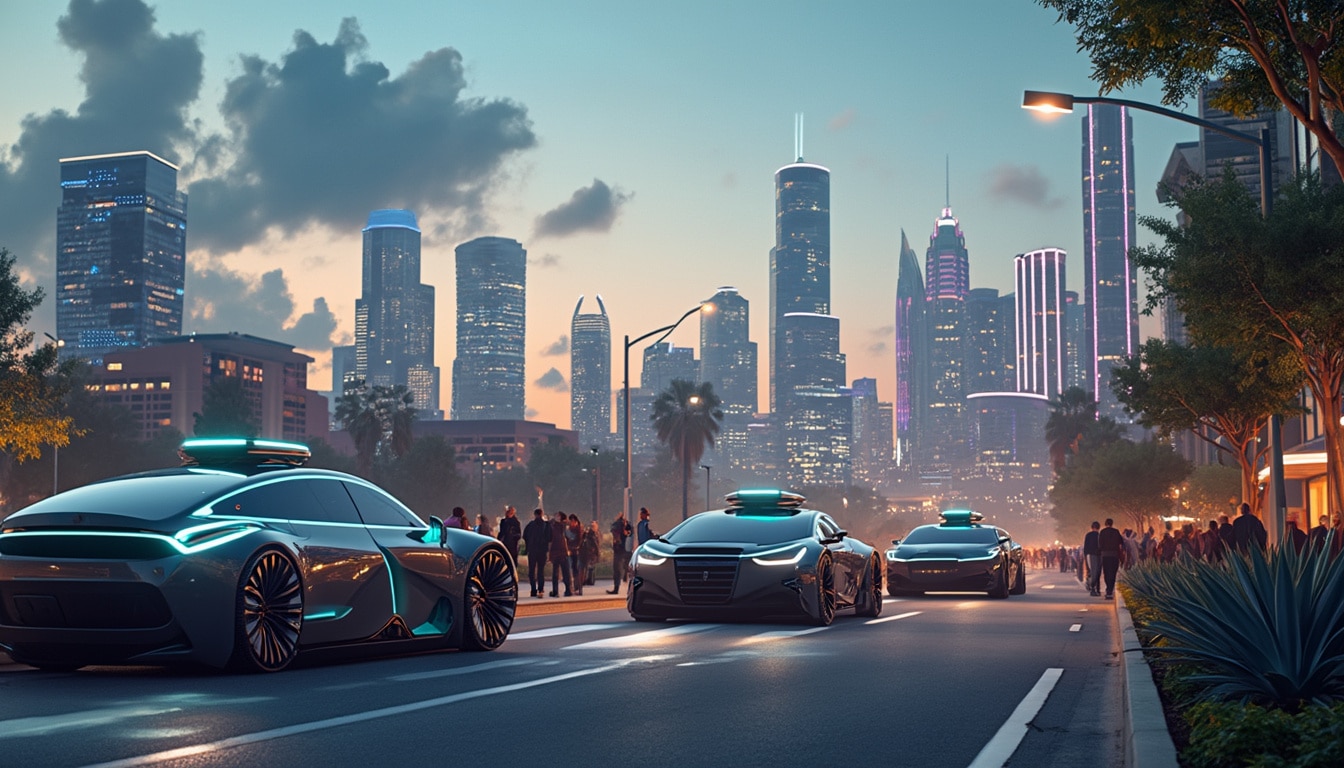Strap in, folks, because the future of transportation is racing toward us at lightning speed. Autonomous vehicles are no longer the stuff of science fiction—they’re our soon-to-be neighbors. From driverless taxis to fully autonomous fleets, the roads are transforming before our very eyes.
In 2025, the autonomous vehicle industry is accelerating into a new era, with Level 4 (L4) vehicles already being tested and deployed. Unlike their Level 3 counterparts, these L4 vehicles don’t require a human ready to take the wheel, signaling a major leap toward fully autonomous transportation. Meanwhile, the quest for Level 5 (L5) vehicles, which promise complete autonomy in any environment, remains the ultimate goal for innovators and investors alike.
Simultaneously, the electric vehicle (EV) market is experiencing an electrifying surge in the United States. In the latter half of 2024 alone, over 700,000 EVs were sold, marking a record high that underscores the nation’s shift toward sustainable mobility. Companies like Waymo are leading the charge, while others like GM’s Cruise division grapple with setbacks that might just lead to smarter strategies down the road.
The financial projections are equally thrilling, with the United States autonomous vehicle market valued at $22.60 billion in 2024 and expected to balloon to $222.80 billion by 2033. This explosive growth, boasting a CAGR of 28.92%, highlights the massive potential and relentless innovation driving the industry forward. As autonomous and electric vehicles continue to intertwine, the transportation landscape is set to become more efficient, sustainable, and downright futuristic.
But it’s not just about the numbers. Consumers are buzzing with excitement, willing to pay premium rates for remote-driving services, and the infrastructure supporting these technologies is expanding rapidly. From multi-camera systems enhancing vehicle perception to sophisticated AI algorithms powering self-driving capabilities, the blend of technology and creativity is paving the way for a revolutionary transformation in how we move.
« `html
The automotive landscape in the United States is undergoing a seismic shift, spearheaded by the rise of self-driving vehicles. This burgeoning trend is not only transforming how Americans commute but also reshaping entire industries, from technology to urban planning. As we navigate through 2025, the advancements and innovations in autonomous driving technologies are setting the stage for a future where self-driving cars become an integral part of daily life.
Table of contents
ToggleWhat are the current advancements in autonomous vehicle technology?
Autonomous vehicle technology has made significant strides, particularly with the development and deployment of Level 4 (L4) vehicles. Unlike Level 3 systems that require a driver to take over when necessary, L4 vehicles operate without the need for human intervention under specific conditions. These driverless taxis are currently being tested and rolled out in various urban areas across the United States. Companies like Waymo are leading the charge, demonstrating the potential of fleets that can efficiently transport passengers without human drivers.
Looking ahead, Level 5 (L5) vehicles represent the pinnacle of autonomous driving, capable of operating in any environment and under all conditions without any human input. Achieving L5 autonomy is considered the final frontier in self-driving technology, promising a future where fully autonomous vehicles dominate the roads, offering unparalleled convenience and safety.
How is the autonomous vehicle industry projected to grow?
The autonomous vehicle industry in the United States is poised for exponential growth. According to a report by GlobeNewswire, the market, valued at approximately $22.60 billion in 2024, is expected to skyrocket to $222.80 billion by 2033, reflecting a compound annual growth rate (CAGR) of 28.92% from 2025 to 2033. This rapid expansion is fueled by continuous technological advancements, increased consumer interest, and substantial investments from both established automakers and innovative startups.
McKinsey & Company highlights that despite some setbacks and delays in customer adoption, the broader consensus within the mobility community remains optimistic about the future of autonomous driving. The persistent investment of billions of dollars underscores the industry’s commitment to overcoming current challenges and achieving widespread deployment.
What role do electric vehicles play in this transformation?
The rise of electric vehicles (EVs) is intrinsically linked to the advancement of autonomous driving technologies. As the United States automotive market embraces EVs, sales reached a record high with over 700,000 units sold in the latter half of 2024, according to Cox Automotive. This surge in EV adoption not only supports environmental sustainability but also complements the development of autonomous systems, which often rely on electric powertrains for efficiency and integration with smart technologies.
Electric and autonomous vehicles together pave the way for a more sustainable and technologically advanced transportation ecosystem. The synergy between these two trends accelerates innovation, leading to the creation of vehicles that are not only self-driving but also environmentally friendly. This dual transformation is expected to significantly impact the United States’ automotive market, setting new standards for mobility and sustainability.
Which companies are leading the autonomous vehicle revolution?
The competitive landscape of the autonomous vehicle industry is dynamic, with several key players vying for dominance. Waymo, a subsidiary of Alphabet Inc., continues to lead the charge with its advanced self-driving technology and extensive testing programs. Waymo’s commitment to innovation is evident in its ongoing efforts to refine and expand its autonomous taxi services.
On the other hand, traditional automakers like General Motors (GM) are leveraging their extensive resources to develop comprehensive autonomous solutions. GM’s Cruise division, despite facing disruptions, remains a significant contender in the market. The lessons learned from recent setbacks are expected to position Cruise for stronger performance in the future, as the division enhances its technological capabilities and scales its operations.
Additionally, technology giants such as Tesla are making substantial contributions to the field with their autonomous driving software and over-the-air updates, pushing the boundaries of what self-driving cars can achieve. The collaboration between tech companies and automakers is fostering a rich environment for innovation, accelerating the deployment of autonomous vehicles across the United States.
What are the major challenges facing self-driving cars?
Despite the promising advancements, the path to widespread adoption of self-driving cars is fraught with challenges. One of the primary obstacles is achieving Level 5 autonomy, which requires vehicles to operate flawlessly in any environment. Technical challenges, such as ensuring reliable performance in diverse weather conditions and complex urban settings, remain significant hurdles.
Moreover, ethical and regulatory issues add layers of complexity to the deployment of autonomous vehicles. Determining liability in the event of accidents, establishing clear regulatory frameworks, and ensuring the cybersecurity of self-driving systems are critical areas that need to be addressed.
Another challenge is consumer acceptance. While interest in autonomous vehicles is growing, as evidenced by a McKinsey survey where a significant percentage of car owners expressed willingness to consider remote-driving services, widespread trust in the technology is still building. Public perception and the readiness of infrastructure to support autonomous systems play crucial roles in the successful integration of self-driving cars into society.
How are autonomous vehicles impacting the economy and job market?
The economic impact of autonomous vehicles is multifaceted, influencing various sectors and the overall job market. The growth of the autonomous vehicle industry is expected to create numerous opportunities in technology development, manufacturing, and infrastructure support. However, it also presents challenges, particularly in the transportation and logistics sectors, where traditional driving roles may be reduced as automation takes over.
Furthermore, the integration of autonomous vehicles is likely to stimulate innovation in related industries such as telecommunications, with increased demand for robust connectivity solutions to support vehicle-to-everything (V2X) communication. The rise of self-driving cars also opens avenues for new business models, including mobility-as-a-service (MaaS) platforms that offer on-demand transportation solutions.
Overall, while autonomous vehicles promise economic growth and technological advancement, they also necessitate strategic planning to mitigate potential job displacements and ensure a smooth transition to a more automated transportation ecosystem.
What are the environmental benefits of autonomous and electric vehicles?
The convergence of autonomous vehicles and electric vehicles (EVs) offers significant environmental benefits. Electric-powered autonomous cars produce zero tailpipe emissions, contributing to improved air quality and reduced greenhouse gas emissions. As EV adoption increases, the transportation sector, traditionally a major source of carbon emissions, becomes cleaner and more sustainable.
Moreover, autonomous vehicles can optimize driving patterns, leading to more efficient energy use and reduced traffic congestion. By minimizing unnecessary acceleration and braking, self-driving cars enhance fuel efficiency, further lowering their environmental footprint. Additionally, the integration of smart technologies allows for better traffic management and reduced idle times, contributing to overall energy conservation.
The combination of electric propulsion and autonomous driving not only supports environmental sustainability but also aligns with broader efforts to combat climate change and promote green technologies. This synergy is pivotal in driving the United States towards a more sustainable and eco-friendly transportation future.
How is the infrastructure evolving to support autonomous vehicles?
The successful deployment of autonomous vehicles relies heavily on the evolution of infrastructure to support their unique requirements. Smart infrastructure, equipped with advanced sensors and communication systems, is essential for the seamless operation of self-driving cars. Investments are being made in upgrading roadways with vehicle-to-everything (V2X) communication capabilities, enabling real-time data exchange between vehicles and their surroundings.
Moreover, the development of dedicated lanes and smart traffic signals enhances the efficiency and safety of autonomous driving systems. Urban planning is increasingly incorporating these technologies, creating environments that are conducive to the integration of self-driving cars. The implementation of intelligent transportation systems (ITS) facilitates better traffic management, reducing congestion and improving overall mobility.
Additionally, charging infrastructure for electric autonomous vehicles is expanding, ensuring that these cars remain powered and operational. The synergy between electric and autonomous technologies necessitates a comprehensive infrastructure overhaul, fostering a transportation ecosystem that is efficient, resilient, and adaptable to future innovations.
What is the consumer sentiment towards self-driving vehicles?
Consumer sentiment towards self-driving vehicles is cautiously optimistic. A recent survey by McKinsey revealed that approximately 70% of premium car owners and 55% of midrange car owners are open to using remote-driving services. This indicates a growing acceptance of autonomous technology, particularly among consumers who prioritize advanced features and convenience.
However, consumer trust remains a critical factor in the widespread adoption of self-driving cars. Ensuring the safety, reliability, and transparency of autonomous systems is paramount to gaining public confidence. Educational initiatives and positive user experiences will play a significant role in shaping consumer perceptions and encouraging the transition to automated transportation.
Moreover, the willingness to pay for remote-driving services, with global car owners indicating a readiness to spend around $53 per hour, suggests that there is a viable market for these services. As autonomous technology continues to mature and demonstrate its benefits, consumer enthusiasm is expected to rise, driving further adoption and integration into everyday life.
What does the future hold for autonomous vehicles in the US?
The future of autonomous vehicles in the United States is bright, with numerous innovations and market dynamics steering the industry towards widespread adoption. By 2030, the autonomous driving software market is projected to see significant growth, influenced by continuous advancements in artificial intelligence and machine learning. These technologies are crucial for enhancing the decision-making capabilities of self-driving cars, ensuring they can navigate complex environments with ease.
Industry trends indicate that the next few years will witness a surge in collaborative efforts between automakers, tech companies, and government agencies. This collaboration is essential for addressing regulatory challenges, standardizing technologies, and fostering an environment conducive to innovation. As a result, the integration of autonomous vehicles into the transportation network is expected to become more seamless and efficient.
Events like CES 2025 showcase the latest breakthroughs and set the stage for future developments, highlighting the pivotal role of events in driving the autonomous vehicle agenda forward. Additionally, initiatives focused on the intelligence behind autonomous vehicles emphasize the importance of digital knowledge sharing in fueling innovation and collaboration across the industry.
As technology continues to evolve and societal acceptance grows, autonomous vehicles are set to revolutionize the United States’ transportation landscape. From enhancing mobility and safety to driving economic growth and environmental sustainability, the rise of self-driving cars marks a significant milestone in the journey towards a smarter, more connected future.













